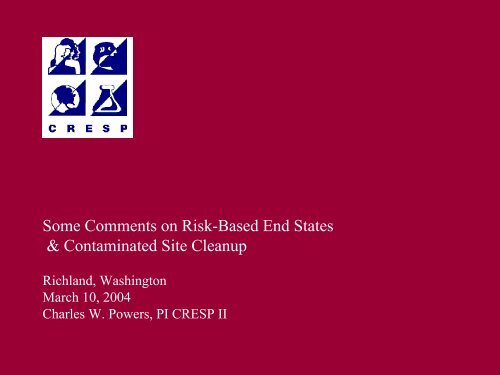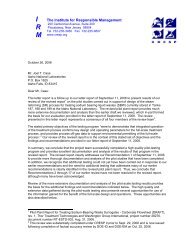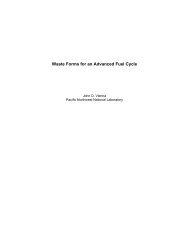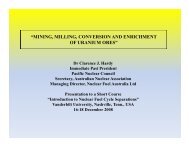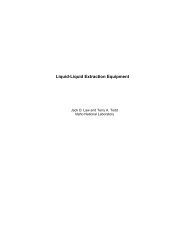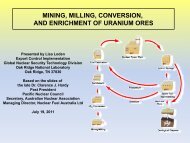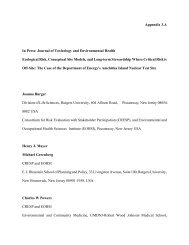View - CRESP Consortium for Risk Evaluation with Stakeholder ...
View - CRESP Consortium for Risk Evaluation with Stakeholder ...
View - CRESP Consortium for Risk Evaluation with Stakeholder ...
You also want an ePaper? Increase the reach of your titles
YUMPU automatically turns print PDFs into web optimized ePapers that Google loves.
Some Comments on <strong>Risk</strong>-Based End States<br />
& Contaminated Site Cleanup<br />
Richland, Washington<br />
March 10, 2004<br />
Charles W. Powers, PI <strong>CRESP</strong> II
• DOE Policy 455.1 - Use of <strong>Risk</strong>-Based<br />
End States (7/15/03)<br />
– RBES are: “representations of site conditions<br />
and associated in<strong>for</strong>mation that reflect the<br />
planned future use of the property and are<br />
appropriately protective of human health and<br />
the environment consistent <strong>with</strong> that use.”
Vision Document Guidance<br />
• Sites are to define risk-based end states that<br />
are sustainably protective of human health and<br />
the environment.<br />
• The RBES depends on the site having defined of<br />
appropriate land uses and their associated<br />
exposure scenarios.<br />
• RBES Vision documents are to define the RBES,<br />
and are not decision documents.
RBES is Today a Lightning Rod<br />
Sites are at very different places in the cleanup/completion process<br />
and the state of the process Is viewed differently by different parties:<br />
Close to closure; don’t disturb;<br />
agreements in place (Regulators and some <strong>Stakeholder</strong>s)<br />
Almost No sites closed; mostly interim agreements (TTBR, DOE)<br />
Closure dates: 1997, 2000, 2006, 2015. 2025, 2035<br />
And parties are energetically using the same words to describe different phenomena<br />
Variances (from final RODs; interim ROD’s; discussed approaches<br />
PMP’s, Site Baselines, what?)<br />
Balancing what?<br />
Balancing Criteria, Cost/Protection Balancing and <strong>Risk</strong> Balancing<br />
Adequate Public: Interaction how much/at what point?
Members of the <strong>CRESP</strong> Peer Review Committee<br />
Peer Review of the<br />
U.S. Department of Energy’s<br />
Use of <strong>Risk</strong> in its Prioritization Process<br />
December 15, 1999<br />
www.cresp.org<br />
Peer Review Committee<br />
of the<br />
<strong>Consortium</strong> <strong>for</strong> <strong>Risk</strong> <strong>Evaluation</strong><br />
<strong>with</strong> <strong>Stakeholder</strong> Participation<br />
317 George Street, Plaza 2<br />
New Brunswick, NJ 08901<br />
Telephone 732-235-9603<br />
FAX 732-235-9607<br />
John F. Ahearne, Ph.D.<br />
Director, the Sigma Xi Center<br />
Eula Bingham, Ph.D.<br />
Professor Environmental Health,<br />
University of Cincinnati<br />
Melvin W. Carter, Ph.D.<br />
nternational Radiation Protection Consultant<br />
William Cooper, Ph.D.<br />
Professor of Environmental Toxicology,<br />
Michigan State University<br />
Brian Costner<br />
Seattle, W ashington*<br />
Kai Erikson, Ph.D.<br />
Prof. of Sociology<br />
Yale University<br />
Charles Fairhurst, Ph.D.<br />
Prof. of Civil & Mineral Engineering<br />
University of Minnesota<br />
Sheila Jasanoff, Ph.D.<br />
Prof. of Science & Public Policy<br />
Harvard University<br />
Frank Parker<br />
Prof. of Engineering,<br />
Vanderbilt University*<br />
Russell Jim<br />
Yakima Indian Nation<br />
Renate D. Kimbrough, M.D.<br />
Institute <strong>for</strong> Evaluating Health <strong>Risk</strong>s<br />
Morton Lippmann, Ph.D.<br />
Professor of Environmental Medicine<br />
NYU Medical Center<br />
Milton Russell, Ph.D.<br />
Emeritus Professor of Economics<br />
University of Tennessee<br />
Sheldon Samuels<br />
Ramazzini Institute, Solomons, Maryland<br />
Mervyn Tano<br />
General Counsel, International Institute <strong>for</strong><br />
Indigenous Resource Management<br />
Victoria Tschinkel<br />
Senior Consultant, Landers and Parsons,<br />
Tallahassee, FL*<br />
Arthur C. Upton, M.D.<br />
Professor Environmental & Community Medicine<br />
UMDNJ-RWJMS **<br />
Bailus Walker, Jr., Ph.D., M.P.H.<br />
Professor of Environmental & Occupational<br />
Medicine, Howard University<br />
Chris Whipple, Ph.D.<br />
ICF Kaiser<br />
Oakland, CA*<br />
Lauren Zeise, Ph.D.<br />
Cali<strong>for</strong>nia Environmental Protection Agency<br />
*Ad Hoc Mem ber of Comm ittee<br />
** Chairm an of Comm ittee
The principal findings resulting from the review can be summarized as<br />
follows:<br />
Peer Review of the<br />
U.S. Department of Energy’s<br />
Use of <strong>Risk</strong> in its Prioritization Process<br />
December 15, 1999<br />
1) In pursuit of the primary goal of DOE’s environmental<br />
management program, which is the protection of human<br />
health and the environment, it is essential that risk be used<br />
as a criterion <strong>for</strong> priority setting and action.<br />
2) DOE’s use of a risk-based approach <strong>for</strong> the purpose has been<br />
mandated by Congress and recommended repeatedly by<br />
external advisors, recognizing that DOE must also consider<br />
other important programmatic objectives, including<br />
compliance <strong>with</strong> pertinent laws and regulations,<br />
minimization of socioeconomic, cultural, and land-use<br />
impacts, and the cost-effectiveness of alternative<br />
remediation options.<br />
3) In recent years, DOE has found none of the various approaches it has explored<br />
<strong>for</strong> prioritizing its environmental management activities to be entirely<br />
satisfactory <strong>for</strong> the purpose, but each approach has been abandoned be<strong>for</strong>e<br />
it could develop adequately, owing largely to lack of confidence in the<br />
approach by DOE and site personnel, and/or lack of support <strong>for</strong> it by other<br />
stakeholders;<br />
My interpretation:<br />
DOE has<br />
Done too little <strong>with</strong><br />
<strong>Risk</strong> – and when<br />
it has started to<br />
do so, it has<br />
been too timid<br />
and tentative<br />
Peer Review Committee<br />
of the<br />
<strong>Consortium</strong> <strong>for</strong> <strong>Risk</strong> <strong>Evaluation</strong><br />
<strong>with</strong> <strong>Stakeholder</strong> Participation<br />
317 George Street, Plaza 2<br />
New Brunswick, NJ 08901<br />
Telephone 732-235-9603<br />
FAX 732-235-9607<br />
www.cresp.org
ERPS<br />
Community<br />
-values<br />
- input<br />
- outreach<br />
RDS's<br />
ADS's<br />
PBS’<br />
<strong>Risk</strong> Profiles<br />
RISKS AND THE RISK DEBATE:<br />
Searching <strong>for</strong> Common Ground<br />
U.S. Department of Energy<br />
Office of Environmental<br />
Management<br />
1995 <strong>Consortium</strong> <strong>for</strong> <strong>Risk</strong> <strong>Evaluation</strong> <strong>with</strong><br />
<strong>Stakeholder</strong> Participation (<strong>CRESP</strong>)<br />
National Review Panel Report<br />
Review of <strong>Risk</strong> Data Sheet In<strong>for</strong>mation<br />
For Fiscal Year 1998<br />
May 14, 1996
Selected<br />
elements<br />
My interpretation:<br />
DOE’s use of<br />
<strong>Risk</strong> has been too<br />
short-term,<br />
Recommendations <strong>for</strong> improving the process include the following:<br />
1) DOE should develop and implement appropriate strategies <strong>for</strong> responsible<br />
interim and long-term stewardship, based on sound principles of risk<br />
assessment and risk management.<br />
4) Specific risk-related issues that deserve increased attention in<br />
the future include:<br />
• The need <strong>for</strong> a more integrated approach to risk<br />
assessment than one that would suffice <strong>for</strong><br />
compliance purposes alone at sites containing<br />
multiple sources of contamination;<br />
• The need to include exposure evaluation as a key step in<br />
any risk assessment;<br />
• The need to assess the potential impacts of remediating activities themselves on the<br />
health of involved workers;<br />
Peer Review of the<br />
U.S. Department of Energy’s<br />
Use of <strong>Risk</strong> in its Prioritization Process<br />
December 15, 1999<br />
• the need, particularly in complex assessments, <strong>for</strong> the Department and its contractors to<br />
provide clear summaries of the potential exposure pathways and hazardous agents in<br />
question, in order that the risk assessments may be more reviewable, credible, and useful<br />
in priority setting.<br />
Peer Review Committee<br />
of the<br />
<strong>Consortium</strong> <strong>for</strong> <strong>Risk</strong> <strong>Evaluation</strong><br />
<strong>with</strong> <strong>Stakeholder</strong> Participation<br />
317 George Street, Plaza 2<br />
New Brunswick, NJ 08901<br />
Telephone 732-235-9603<br />
FAX 732-235-9607<br />
www.cresp.org
Time matters big time <strong>for</strong> DOE Sites:<br />
<strong>Evaluation</strong> must address time<br />
either hazards eliminated or pathway blocked prior to contact<br />
Situation<br />
Hazard<br />
TIME<br />
TIME<br />
Hazard<br />
TIME<br />
Transport<br />
TIME<br />
B<br />
L<br />
O<br />
C<br />
K<br />
E<br />
D<br />
TIME<br />
TIME<br />
TIME<br />
Receptor<br />
Dose<br />
public,worker,eco<br />
C. Powers<br />
TIME
Selected<br />
elements<br />
My interpretation:<br />
DOE’s use of<br />
<strong>Risk</strong> has been too<br />
short-term, too<br />
narrow,<br />
Recommendations <strong>for</strong> improving the process include the following:<br />
1) DOE should develop and implement appropriate strategies <strong>for</strong> responsible<br />
interim and long-term stewardship, based on sound principles of risk<br />
assessment and risk management.<br />
4) Specific risk-related issues that deserve increased attention in<br />
the future include:<br />
• The need <strong>for</strong> a more integrated approach to risk<br />
assessment than one that would suffice <strong>for</strong><br />
compliance purposes alone at sites containing<br />
multiple sources of contamination;<br />
• The need to include exposure evaluation as a key step in<br />
any risk assessment;<br />
• The need to assess the potential impacts of remediating activities themselves on the<br />
health of involved workers;<br />
Peer Review of the<br />
U.S. Department of Energy’s<br />
Use of <strong>Risk</strong> in its Prioritization Process<br />
December 15, 1999<br />
• the need, particularly in complex assessments, <strong>for</strong> the Department and its contractors to<br />
provide clear summaries of the potential exposure pathways and hazardous agents in<br />
question, in order that the risk assessments may be more reviewable, credible, and useful<br />
in priority setting.<br />
Peer Review Committee<br />
of the<br />
<strong>Consortium</strong> <strong>for</strong> <strong>Risk</strong> <strong>Evaluation</strong><br />
<strong>with</strong> <strong>Stakeholder</strong> Participation<br />
317 George Street, Plaza 2<br />
New Brunswick, NJ 08901<br />
Telephone 732-235-9603<br />
FAX 732-235-9607<br />
www.cresp.org
Fed<br />
ARAR’s<br />
State<br />
Laws &<br />
ARAR’s<br />
CERCLA<br />
RCRA<br />
State Regulators<br />
EPA<br />
AEA<br />
E&H<br />
NEPA<br />
Natural<br />
Resource<br />
Trustees<br />
Local/Regional<br />
Gov’ts/Boards<br />
Adjacent<br />
State<br />
Regulators<br />
DNFSB<br />
NRC<br />
A Very Rich Regulatory Mix
Selected<br />
elements<br />
My interpretation:<br />
DOE’s use of<br />
<strong>Risk</strong> has been too<br />
short-term, too<br />
narrow, too focused<br />
on hazards not<br />
risks,<br />
Recommendations <strong>for</strong> improving the process include the following:<br />
1) DOE should develop and implement appropriate strategies <strong>for</strong> responsible<br />
interim and long-term stewardship, based on sound principles of risk<br />
assessment and risk management.<br />
4) Specific risk-related issues that deserve increased attention in<br />
the future include:<br />
• The need <strong>for</strong> a more integrated approach to risk<br />
assessment than one that would suffice <strong>for</strong><br />
compliance purposes alone at sites containing<br />
multiple sources of contamination;<br />
• The need to include exposure evaluation as a key step in<br />
any risk assessment;<br />
• The need to assess the potential impacts of remediating activities themselves on the<br />
health of involved workers;<br />
Peer Review of the<br />
U.S. Department of Energy’s<br />
Use of <strong>Risk</strong> in its Prioritization Process<br />
December 15, 1999<br />
• the need, particularly in complex assessments, <strong>for</strong> the Department and its contractors to<br />
provide clear summaries of the potential exposure pathways and hazardous agents in<br />
question, in order that the risk assessments may be more reviewable, credible, and useful<br />
in priority setting.<br />
Peer Review Committee<br />
of the<br />
<strong>Consortium</strong> <strong>for</strong> <strong>Risk</strong> <strong>Evaluation</strong><br />
<strong>with</strong> <strong>Stakeholder</strong> Participation<br />
317 George Street, Plaza 2<br />
New Brunswick, NJ 08901<br />
Telephone 732-235-9603<br />
FAX 732-235-9607<br />
www.cresp.org
RBES Exposure Scenarios in the Context of Land Use<br />
C. Powers<br />
Hazard<br />
Receptor<br />
worker<br />
Receptor<br />
ecological<br />
Receptor<br />
public<br />
D<br />
B<br />
L<br />
O<br />
C<br />
K<br />
E<br />
D<br />
?<br />
Receptors<br />
public,worker,eco<br />
Developed by Charles W. Powers
Selected<br />
elements<br />
My interpretation:<br />
DOE’s use of<br />
<strong>Risk</strong> has been too<br />
short-term, too<br />
narrow, too focused<br />
on hazards not<br />
risks, failed to<br />
risk balance<br />
Recommendations <strong>for</strong> improving the process include the following:<br />
1) DOE should develop and implement appropriate strategies <strong>for</strong> responsible<br />
interim and long-term stewardship, based on sound principles of risk<br />
assessment and risk management.<br />
4) Specific risk-related issues that deserve increased attention in<br />
the future include:<br />
• The need <strong>for</strong> a more integrated approach to risk<br />
assessment than one that would suffice <strong>for</strong><br />
compliance purposes alone at sites containing<br />
multiple sources of contamination;<br />
• The need to include exposure evaluation as a key step in<br />
any risk assessment;<br />
• The need to assess the potential impacts of remediating activities themselves on the<br />
health of involved workers;<br />
Peer Review of the<br />
U.S. Department of Energy’s<br />
Use of <strong>Risk</strong> in its Prioritization Process<br />
December 15, 1999<br />
• the need, particularly in complex assessments, <strong>for</strong> the Department and its contractors to<br />
provide clear summaries of the potential exposure pathways and hazardous agents in<br />
question, in order that the risk assessments may be more reviewable, credible, and useful<br />
in priority setting.<br />
Peer Review Committee<br />
of the<br />
<strong>Consortium</strong> <strong>for</strong> <strong>Risk</strong> <strong>Evaluation</strong><br />
<strong>with</strong> <strong>Stakeholder</strong> Participation<br />
317 George Street, Plaza 2<br />
New Brunswick, NJ 08901<br />
Telephone 732-235-9603<br />
FAX 732-235-9607<br />
www.cresp.org
Remediation<br />
Worker<br />
Ecological<br />
Regular<br />
Worker<br />
Public<br />
Health/Safety<br />
be<strong>for</strong>e during after<br />
project<br />
50<br />
period<br />
40<br />
30<br />
20<br />
10<br />
Intense<br />
Remedial<br />
Intervention<br />
0<br />
1996 1997 1998 2000 2006 2020<br />
2002 2006 2040 2102<br />
What Remedy Best Achieves<br />
A <strong>Risk</strong>-based End State?<br />
Vision Document Guidance<br />
directs sites to define risk-based end states<br />
that are sustainably protective of human<br />
Economic<br />
Remediation Worker<br />
Enviro Protection<br />
Worker S&H<br />
health and the environment.<br />
Public H&S<br />
Soc/Cultural<br />
Economic<br />
Protection of Health<br />
and Environment<br />
Public<br />
Health/Safety<br />
1996 1997 1998 2000 2006 2020<br />
Economic<br />
Long-term effectiveness/permanence<br />
Short-term effectiveness<br />
– adverse impacts on health/environment<br />
during implementation of remedy<br />
30<br />
25<br />
20<br />
15<br />
10<br />
Graduated<br />
Remediation<br />
Remediation<br />
Worker<br />
other<br />
Economic<br />
Remediation Worker<br />
Enviro Protection<br />
Worker S&H<br />
Public H&S<br />
Ecological<br />
Developed by Charles W. Powers<br />
5<br />
0<br />
1996 1997 1998 2000 2006 2020<br />
Year<br />
2002 2006 2040 2102<br />
Regular<br />
Worker
Selected<br />
elements<br />
My interpretation:<br />
DOE’s use of<br />
<strong>Risk</strong> has been too<br />
short-term, too<br />
narrow, too focused<br />
on hazards not<br />
risks, failed to<br />
risk balance<br />
and is not<br />
transparent enough<br />
Recommendations <strong>for</strong> improving the process include the following:<br />
1) DOE should develop and implement appropriate strategies <strong>for</strong> responsible<br />
interim and long-term stewardship, based on sound principles of risk<br />
assessment and risk management.<br />
4) Specific risk-related issues that deserve increased attention in<br />
the future include:<br />
• The need <strong>for</strong> a more integrated approach to risk<br />
assessment than one that would suffice <strong>for</strong><br />
compliance purposes alone at sites containing<br />
multiple sources of contamination;<br />
• The need to include exposure evaluation as a key step in<br />
any risk assessment;<br />
• The need to assess the potential impacts of remediating activities themselves on the<br />
health of involved workers;<br />
Peer Review of the<br />
U.S. Department of Energy’s<br />
Use of <strong>Risk</strong> in its Prioritization Process<br />
December 15, 1999<br />
• the need, particularly in complex assessments, <strong>for</strong> the Department and its contractors to<br />
provide clear summaries of the potential exposure pathways and hazardous agents in<br />
question, in order that the risk assessments may be more reviewable, credible, and useful<br />
in priority setting.<br />
Peer Review Committee<br />
of the<br />
<strong>Consortium</strong> <strong>for</strong> <strong>Risk</strong> <strong>Evaluation</strong><br />
<strong>with</strong> <strong>Stakeholder</strong> Participation<br />
317 George Street, Plaza 2<br />
New Brunswick, NJ 08901<br />
Telephone 732-235-9603<br />
FAX 732-235-9607<br />
www.cresp.org
Today there is apparent Unanimity<br />
on one RBES issue:<br />
It is a major advance to<br />
have common maps and CSM’s<br />
through which to understand sites<br />
and from which to be able to compare<br />
current and risk-based<br />
end-state scenarios<br />
Source<br />
Depletion<br />
<strong>with</strong>Vapor<br />
Extraction<br />
Landfill containing<br />
chemical and<br />
radiological<br />
contaminants<br />
Access<br />
Restrictions<br />
Workplan<br />
Reviews<br />
Cap<br />
Limits<br />
Transport<br />
Out<br />
Prevents<br />
Wind<br />
Contact<br />
Prevents<br />
Shallow<br />
Contact<br />
Example of Post-Completion Conceptual Site Model<br />
Volitalization<br />
Resuspension<br />
Direct Contact<br />
Air<br />
wind/dispersion<br />
deposition<br />
Surface<br />
Water<br />
Land Use<br />
Restrictions in<br />
Buffer Zone<br />
On<br />
Site<br />
Worker<br />
I<br />
F/D<br />
Area<br />
Res.<br />
I<br />
F/D<br />
Future<br />
Area<br />
Res.<br />
I<br />
F/D<br />
F/D<br />
Eco.<br />
I<br />
F/D<br />
F/D<br />
Run on/<br />
Run off<br />
Controls<br />
Prevents<br />
Direct<br />
Contact<br />
Prevents<br />
Percolation<br />
Runoff<br />
Infiltration<br />
Ground<br />
Water<br />
Surface<br />
Water<br />
discharge<br />
F/D<br />
I/F/D<br />
F/D<br />
I/F/D<br />
F/D<br />
KEY<br />
Potential exposure or transport pathway<br />
Blocked exposure or transport pathway<br />
Engineered or administrative barrier<br />
Water<br />
Withdrawal<br />
Restrictions<br />
I Inhalation<br />
F Ingestion<br />
D Dermal Contact<br />
Components of End State<br />
Description<br />
Waste Characteristics<br />
Unit Characteristics<br />
Barriers in Place<br />
Other Key Assumptions to<br />
Maintain Protectiveness<br />
One landfill remains on site. Contaminants include: NO, CHCL, DCE, Toluene, H3, C14, and DCA. The estimated volume of material disposed in the landfill<br />
is 420,000 y3, based on historical records and knowledge of past practices.<br />
Landfill is approximately 50 - 60 feet above the upper huydrostratigraphic unit (HSU) and approximately 80 ft. above the lower HSU of the groundwater<br />
aquifer. The contaminants detected in the upper HSU include: CHCl3, DCA, Cr, NO3, DCE, Toluene, H3, and C14. Contaminants detected in lower HSU<br />
include: Cr, NO, CHCl3, DCE, Toluene, H3, C14, and DCA.<br />
One single-layer cap <strong>with</strong> a design life of 30 years covers the landfill. Vapor extraction system installed and operated until concentrations drop below<br />
threshold. Land use restriction covenants in place such that: (1) There can be no digging in the landfill area; and (2) There shall be no agriculture or<br />
residential use of groundwater; pumping groundwater from wells is prohibited.<br />
Land use will remain industrial. Monitored natural attenuation will demonstrate that contaminants in the groundwater are below MCLs in 20 years.<br />
Remaining contaminants in landfill are will not continue to leach to the groundwater. An alternate water supply is provided to local residents.
Introduction to the Session<br />
Obstacles and Resolutions on Site Land Use<br />
by Charles W. Powers, PI <strong>CRESP</strong> II<br />
TIE Conference<br />
Albequerque, New Mexico<br />
November 12. 2001<br />
• Name: 116-C-1 Process Effluent<br />
Trench<br />
• Location: 100-BC Area (GIS<br />
coordinates)<br />
• Type: Process Effluent Trench<br />
learn more<br />
• Status: Complete (see CVP 98-<br />
0006)<br />
• Excavation Diagram<br />
• Dimensions:<br />
– Site Depth Designation:<br />
Intermediate<br />
– Rectangular: 167 m x 32 m x 5.2<br />
m (548 ft x 105 ft x 17 ft)<br />
– Volume: 31,957 CM (41,799 LCY)<br />
• Contaminants of concern:<br />
– Radionuclides: 137 CS, 152 EU, 239/240 PU,<br />
241<br />
AM, 60 CO, 154 EU, 155 Eu, 238 Pu, 90 Sr,<br />
238<br />
U,<br />
– Inorganics: Cr(total), Cr +6 (Hex), Hg,<br />
Pg, Sb<br />
• Cost<br />
• <strong>Risk</strong> estimates<br />
• Back to the 100-B/C Area Map<br />
<strong>CRESP</strong> has long believed geographical clarity<br />
Is needed - <strong>for</strong> example:<br />
Decision Mapping System<br />
116-C-1 Waste-site In<strong>for</strong>mation<br />
Developed by <strong>CRESP</strong><br />
Researcher, Christie Drew<br />
• Decision In<strong>for</strong>mation<br />
• 100 Area Soil cleanup<br />
ROD<br />
• TPA Milestones<br />
• Related (Analogous) sites list<br />
• Make a comment<br />
• Sources<br />
Sources: DOE, 1999. Cleanup Verification Package (CVP-98-0006) and<br />
DOE 1998, Remedial Design Report/Remedial Action Work Plan <strong>for</strong> the 100 Area. (DOE RL-96-17)
<strong>CRESP</strong> has long pushed <strong>for</strong> geographical clarity
But <strong>Risk</strong>-Based End States<br />
Flows too easily; it is a complicated concept –<br />
We have to understand the relationship<br />
Between the adjective and the noun<br />
<strong>Risk</strong> - Based<br />
End States<br />
Probability & consequence sustainably protective
<strong>Risk</strong>-Based?: it is not so easy even <strong>with</strong>in CERCLA<br />
EPA’s Genl & CERCLA<br />
<strong>Risk</strong> Assessment<br />
Guidleines<br />
Exposure Assessments<br />
and Land Use<br />
Points of Compliance<br />
eg., <strong>for</strong> MCL’s<br />
MEI’s in RME Scenarios<br />
<strong>Risk</strong> Range (cancer/noncancer)<br />
Deterministic/Probabilistic RA’s<br />
Relationship of<br />
Baseline to Post-<br />
Remedy Assessments<br />
Nine CERCLA Criteria <strong>for</strong><br />
Remedy Selection<br />
Threshold Criteria<br />
Protection of Health and Environment<br />
ARAR’s (unless waived*)<br />
Balancing Criteria<br />
Long-term effectiveness/permanence<br />
Reduction of toxicity/mobility/or<br />
volume through treatment<br />
Short-term effectiveness – adverse<br />
impacts on health/environment during<br />
implementation of remedy<br />
Implementability/feasibility<br />
Cost (including capital, O&M, NPW costs)<br />
Modifying Crtiteria<br />
State Acceptance<br />
Community Acceptance<br />
* Specific procedures
The Related Law Core<br />
Protection of Health<br />
and Environment<br />
Long-term effectiveness/permanence<br />
Short-term effectiveness<br />
– adverse impacts on health/environment<br />
during implementation of remedy<br />
The <strong>Risk</strong> Core<br />
<strong>Risk</strong> Balancing<br />
ARAR’s<br />
----- Balancing -----<br />
Reduction of toxicity/mobility/or<br />
volume through treatment<br />
Implementability/feasibility<br />
Cost (including capital,<br />
O&M, NPW costs)<br />
The How to do it Core<br />
Balancing<br />
Criteria<br />
State Acceptance<br />
Community Acceptance<br />
Public Involvement<br />
Acceptance Core<br />
Threshold<br />
Balancing<br />
Modifying
Two Approaches to <strong>Risk</strong> Reduction<br />
Separate Step-by-Step Reduction w/ no Final Goals Specified<br />
100<br />
Lost in the process?<br />
50<br />
0<br />
Interim 1 Interim 2 Interim 3 ?<br />
? End state<br />
Compliance/<strong>Risk</strong><br />
Objectives<br />
Efficiency-Focused on Well-characterized and Defined Goals<br />
100<br />
50<br />
0<br />
Developed by Charles W. Powers<br />
End State<br />
Goal<br />
<strong>Risk</strong>-Based
End States<br />
Current<br />
Remediation<br />
Work<br />
Looking at the present<br />
from the end-state future<br />
- a refreshing new start<br />
but completely unrealistic<br />
as a stand alone approach?<br />
Developed by Charles W. Powers<br />
<strong>CRESP</strong> to the BRWM – August 2001
That is not a rhetorical question<br />
What would we have to have<br />
to define and support risk-based end-states?<br />
We would Possess:<br />
An ability to have adequately<br />
characterized the contamination,<br />
to have <strong>for</strong>ecast goals <strong>for</strong> remediation<br />
effectiveness, linked those goals<br />
to a monitored future use,<br />
and then <strong>for</strong>ecast the controls<br />
needed to anticipate failure, to<br />
secure the blocked pathway<br />
and to monitor per<strong>for</strong>mance<br />
and assure long-term oversight<br />
as required<br />
Adequate<br />
Characterization<br />
Remediation<br />
Goals<br />
End-State<br />
Institutional Controls<br />
Monitoring and FA<br />
Future use<br />
We think these are the basic elements – and they are not yet achieved<br />
Developed by Charles W. Powers
RBES Exposure Scenarios in the Context of Land Use<br />
C. Powers<br />
Developed by Charles W. Powers<br />
Hazard<br />
Receptor<br />
worker<br />
Receptor<br />
ecological<br />
Receptor<br />
public<br />
D<br />
B<br />
L<br />
O<br />
C<br />
K<br />
E<br />
D<br />
?<br />
ILUCS?<br />
Monitoring?<br />
Failure Analysis?<br />
Receptors<br />
public,worker,eco
RBES is Today a Lightning Rod<br />
But again – why now?<br />
Sites are at very different places in the cleanup/completion process<br />
and the state of the process Is viewed differently by different parties:<br />
Close to closure; don’t disturb;<br />
agreements in place (Regulators and some <strong>Stakeholder</strong>s)<br />
Almost No sites closed; mostly interim agreements (TTBR, DOE)<br />
2000, 2006, 2015. 2025, 2035
RBES: Are Sustainable Solutions <strong>for</strong> DOE Cleanup essential?<br />
Very<br />
High<br />
Safe,<br />
Protective<br />
<strong>Risk</strong><br />
Today<br />
Time<br />
If the wastes at DOE’s EM sites were<br />
not currently addressed by active systems<br />
of controls, barriers and protections, they individually<br />
and collectively would pose a VERY substantial<br />
<strong>Risk</strong> to the public, workers and the environment<br />
Today is there a crisis?<br />
But because risks at these sites are<br />
Actively managed, albeit through an<br />
enormously costly set of measures (many<br />
of which are inefficient, contradictory<br />
and short-term), the current <strong>Risk</strong> posed by<br />
DOE sites is quite low<br />
Duration of Persistent Hazards<br />
This graphic grew out of discussions between Paul Golan (DOE-EM) and Chuck Powers (<strong>CRESP</strong>)
RBES: Are Sustainable Solutions <strong>for</strong> DOE Cleanup essential?<br />
Very<br />
High<br />
1) the current system is not sustainable w/o remedial planning designed <strong>for</strong> longterm<br />
protection as DOE reduces its footprint<br />
<strong>Risk</strong><br />
those systems<br />
are in place so the<br />
situation today is<br />
Currently Protective<br />
Unless<br />
Yet even this<br />
system will become<br />
progressively<br />
more <strong>Risk</strong>y over time<br />
as infrastructure fails<br />
DOE’s land needs retract<br />
Safe,<br />
Protective 2003 2015 2030 2130<br />
Time<br />
Made Sustainably Protective<br />
This graphic grew out of discussions between Paul Golan (DOE-EM) and Chuck Powers (<strong>CRESP</strong>)
RBES: Are Sustainable Solutions <strong>for</strong> DOE Cleanup essential?<br />
Very<br />
High<br />
And : 2) major national investment in this cleanup will atrophy; yet current<br />
(expensive) interim measures yield partial cleanup not sustainability<br />
<strong>Risk</strong><br />
Current Situation, but <strong>for</strong><br />
the “mitigation systems”<br />
at many DOE sites<br />
And, in fact,<br />
the actual<br />
situation today is<br />
Currently Safe<br />
but<br />
Too much ef<strong>for</strong>t being<br />
given to short-term<br />
interim solutions<br />
Safe,<br />
Protective<br />
Developed by Charles W. Powers<br />
2003 2015 2030 2300<br />
Time<br />
NOT Sustainably Safe Ones
Charles W. Powers<br />
Charles W. Powers, Ph.D. is the Principal Investigator of the <strong>Consortium</strong> <strong>for</strong> <strong>Risk</strong><br />
<strong>Evaluation</strong> <strong>with</strong> <strong>Stakeholder</strong> Participation, a university consortium led by faculty from<br />
six major research universities that has, <strong>for</strong> nine years, focused on ways to use risk<br />
concepts to accelerate protective cleanup of the Department of Energy’s legacy waste<br />
sites. He is also Professor of Environmental and Occupational Medicine at Robert Wood<br />
Johnson Medical School-University of Medicine and Dentistry of New Jersey and<br />
President of the Institute <strong>for</strong> Responsible Management (IRM), a non-profit corporation<br />
located in Piscataway, New Jersey. IRM is the recipient of the <strong>CRESP</strong> grant from DOE.<br />
(See www.cresp.org.)<br />
Powers is a graduate of Yale University, Ox<strong>for</strong>d University, Union Theological Seminary<br />
and Haver<strong>for</strong>d College. He has served on the faculties of Yale, Harvard, Tufts and<br />
Princeton universities in addition to his current academic assignment at UMDNJ. He was<br />
the founding chief executive of The Health Effects Institute, Clean Sites Inc., HEI-<br />
Asbestos Research, and the Custodial Trustee <strong>for</strong> the Industriplex Superfund Site in<br />
Massachusetts. He was <strong>for</strong> 6 years the PI on IRM’s co-operative agreement <strong>with</strong> EPA to<br />
support and track the development of Brownfields through the Agency’s Brownfields<br />
Pilot Program, a program he conceived in 1994. Earlier he was the Counselor to Senator<br />
Bill Bradley and Vice President <strong>for</strong> Public Policy at Cummins Engine Company where he<br />
was the chief environmental officer of the Company. He currently chairs the NY<br />
Academy of Science <strong>Consortium</strong> on the NY/NJ Harbor.


